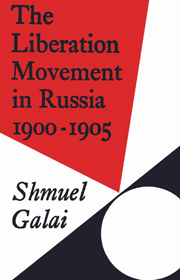Book contents
- Frontmatter
- Contents
- Dedication
- Acknowledgments
- Note on dates, etc.
- List of abbreviations
- Introduction
- Part One ORIGINS
- Part Two THE FORMATION OF THE LIBERATION MOVEMENT
- 5 The launching of the Liberation Movement
- 6 The organization of public opinion
- 7 The intelligentsia in ascendency
- 8 The formation of the Union of Liberation
- Part Three WAR AND REVOLUTION
- Appendix A The origins of Beseda
- Appendix B A bibliographical note on the writings of Kuskova and Prokopovich in the years 1898–9
- Appendix C Note on sources on the formation of the Liberation Movement
- Bibliography
- Index
5 - The launching of the Liberation Movement
Published online by Cambridge University Press: 22 September 2009
- Frontmatter
- Contents
- Dedication
- Acknowledgments
- Note on dates, etc.
- List of abbreviations
- Introduction
- Part One ORIGINS
- Part Two THE FORMATION OF THE LIBERATION MOVEMENT
- 5 The launching of the Liberation Movement
- 6 The organization of public opinion
- 7 The intelligentsia in ascendency
- 8 The formation of the Union of Liberation
- Part Three WAR AND REVOLUTION
- Appendix A The origins of Beseda
- Appendix B A bibliographical note on the writings of Kuskova and Prokopovich in the years 1898–9
- Appendix C Note on sources on the formation of the Liberation Movement
- Bibliography
- Index
Summary
While Struve was negotiating with the orthodox Marxists in Munich, the oppositional mood of society in Russia was reaching boiling-point. D. S. Sipyagin, who replaced Goremykin as Minister of the Interior on 20 October 1899, succeeded, during his relatively short term of office (he was assassinated on 2 April 1902), in antagonizing almost every stratum of educated society. According to the well-informed Polovtsev, Sipyagin was an ‘idiot’ whose chief qualification for his job was his belief in police rule and his submission to Witte. His confidence in police rule was immediately reflected in the tightening of press censorship, which affected even such a loyal newspaper as Novoye Vremya. At the same time, his belief in Witte led him to introduce a series of measures aimed at drastically curtailing the activities of the zemstvos.
The governmental measure which hit the zemstvo activists hardest was the ‘Law Regarding the Fixation of Limits to Zemstvo Taxation’ promulgated on 12 June 1900. Under this law, any increase of 3 per cent or more in zemstvo taxation of immovable property had to be approved in advance by the Ministers of Finance and the Interior. Coming as it did shortly after the contents of Witte's secret memorandum had become known, the law could only be interpreted by the zemstvo activists as further proof of the intention of the government to abolish the zemstvo institutions altogether or to restrict their activity to such an extent that they would remain zemstvo institutions in name only.
- Type
- Chapter
- Information
- The Liberation Movement in Russia 1900–1905 , pp. 109 - 132Publisher: Cambridge University PressPrint publication year: 1973

